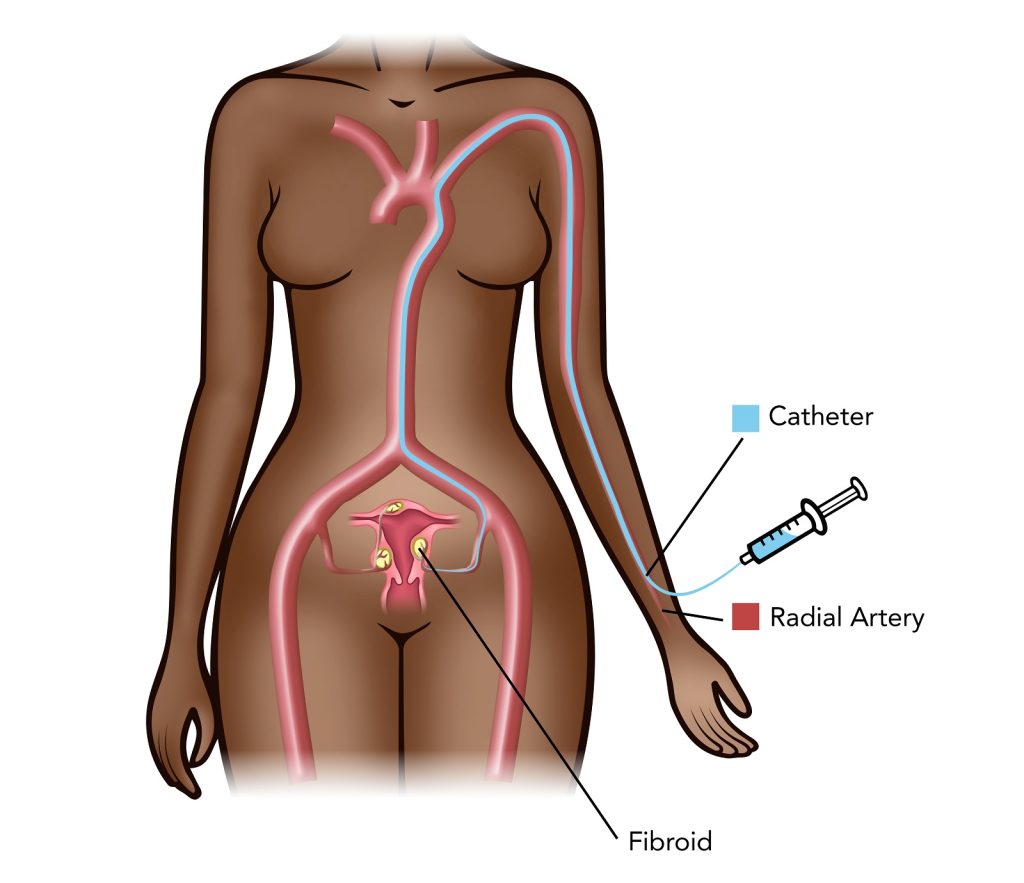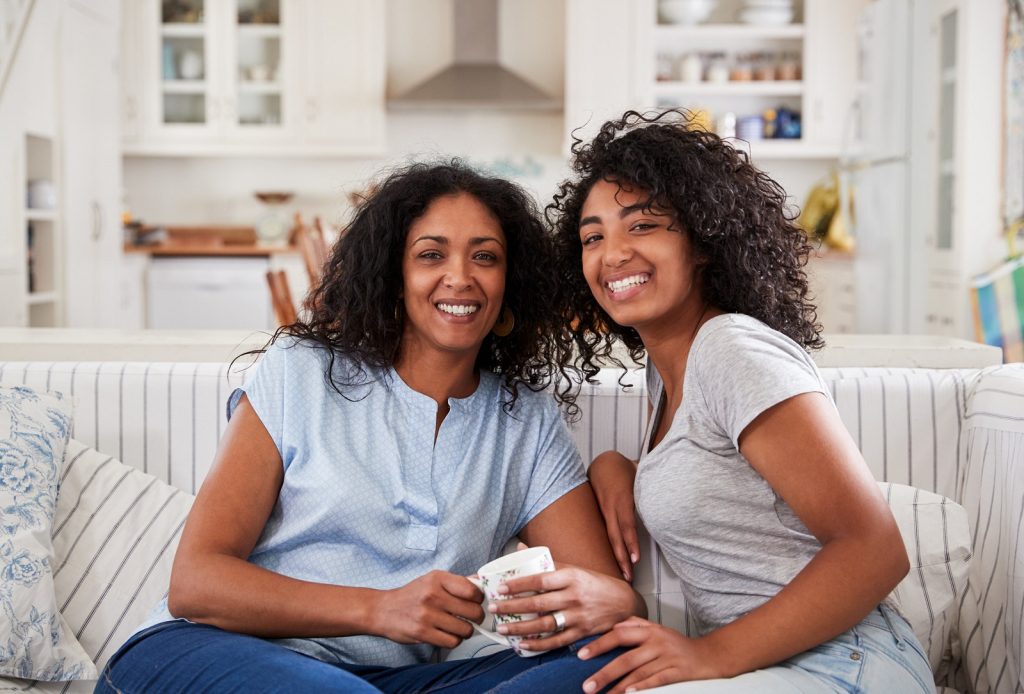Dear Daughter, I have always strived to be open and honest with you about the physiological aspects of being a woman. I’ve stressed the importance of maintaining physical health, self-care, and loving our bodies at every stage, shape, and size. We’ve talked about menstrual cycles, hormonal changes, and the miracle of childbirth. From taking the fear out of using tampons to core values around physical intimacy, I hope that I have been a worthy guide. But there is one topic that we need to cover as it is a challenge you will likely face. We need to talk about living with fibroids.
My grandmother had fibroids, my mother had fibroids and I had fibroids, too. There is a strong chance that someday you will be living with fibroids as well. “What are fibroids?” you may ask. Uterine fibroids are benign tumors that develop from the muscle tissue of the uterus. They can be different sizes and form in different locations. Sometimes they stay the same size and sometimes they grow. Also, some women never have symptoms and only learn they have fibroids after a pelvic exam. Other women, like me, experience symptoms that affect everyday life.
How Did Living with Fibroids Affect Me?
Every month, my period would be super heavy, and some months last a really long time, longer than usual. If I wasn’t running to the bathroom to pee, I would be going to change my tampon and back-up pad every hour or two. I certainly wasn’t going for a bowel movement (yes, constipation is a symptom of fibroids, too!). I was crampy and felt a lot of pressure in my abdomen. Do you know the type of pelvic cramps you also feel in your legs? Yep, I had those, too. I thought about finding a menstrual diaper for sleeping in! I was so worried about bleeding onto my pajamas and the sheets.
Would you believe fibroids changed my clothing style? Yes, your mom used to be a fashionista. But living with fibroids made me pack a bag with extra clothes, pads and tampons, and wipes to have at all times. I was prepared for changing 4 or 5 times per hour because of the tsunami of blood that could come gushing at any moment. I stopped wearing light colored clothing—black became my favorite.
Fibroids canceled my social plans, made me miss work or lunch dates. During my cycles I fought to muster energy to walk, do normal chores, or even just try to have enough energy to live like normal.
I didn’t get a lot accomplished those days. I was tired, cranky, and frustrated. I sometimes needed to take days off from work. There were times it felt like fibroids were controlling my hormones, leaving me feeling like I was on an emotional rollercoaster. Some months, fibroids left me with incontinence. There were times I lived on laxatives just to get relief. I tried my best to still be there for you, but sometimes I just needed to practice self-care.
Common Fibroid Symptoms
- Heavy or inconsistent menstrual bleeding
- Debilitating cramps, pelvic pain, and pressure
- Back or leg pain
- Pain during sexual intercourse
- Urinary frequency
- Periods that last longer than a week
- Excessive fatigue
- Bloating or swelling in the lower abdomen
What Can Fibroids Do to You?
I hope you never get fibroids. But 3 out of 4 women do by the time they reach 50. Plus, not only do we have a hereditary component, but Black women are more likely to develop fibroids—three times more likely than any other ethnic group!
Fibroids can range from the size of a grape to the size of a watermelon. They often come in multiples and give you a “never ending pregnant belly” by bloating your abdomen. I read somewhere that the average weight of fibroids is about 32 lbs. Between you and me, it’s like carrying a bowling ball inside your uterus! It can cause a host of problems from hair loss to malnutrition because you can’t eat properly (you have no room in your stomach). It can also cause miscarriages, nonstop hemorrhages, and blood clots. Fibroids can lead to anemia, leaving you looking pale, yellow, gray gums and blue lipped.
If you end up living with fibroids, you might lose sleep from constant cramping and visiting the toilet every hour to expel blood clots and change out pads. In fact, just wear an adult diaper (it’s easier). You may lose your sex appeal because fibroids can make you feel ugly and not attractive.
People who don’t have the experience of living with fibroids often say, “It can’t be that bad?!?” It’s easy to get upset but forgive them because they have no idea what you are going through. That’s why fibroids can affect your social circle and isolate you from your friends. My own friends got tired of my complaints of “not feeling good” making me feel like the wet blanket of my group. It’s no wonder fibroids can create depression, isolation, fear and anger.
You can help manage your risk factors by limiting the amount of red meat and sugar you eat. There is a reason I kept encouraging you to eat a lot of fruits and vegetables! Also, by maintaining a healthy weight and getting plenty of exercise, you can help reduce your risk of living with fibroids. And while it’s almost impossible to live without any stress, finding ways to lower stress levels can help, too.
In some ways I was lucky. I never had to go to the ER for treatment of anemia and severe blood loss. And thankfully your dad was with me at every step. He was so understanding, supportive and had some flexibility to work from home too. But I was tired of living with fibroids. I was tired of the bloating, the pain, and not being able to live my life to the fullest. I wanted to wear white pants without being paranoid. I wanted to have control of my periods instead of my periods having control over me.
I was tired of living with fibroids. I wanted to have control of my periods instead of my periods having control over me.
I talked to my gynecologist about my continuing fibroid symptoms. He recommended a hysterectomy. Being a mom and working too, I wasn’t ready to go under the knife unless it was absolutely essential. I was afraid of the surgery risks, hormonal effects, and more. Plus, 4-6 weeks is a long recovery time. Between my responsibilities at home and work, it would be hard to schedule. I thought long and hard about what was best for me: giving in to a hysterectomy and the removal of my uterus or living with fibroids.
I really wanted to find a better solution. I’m always amazed by the new technologies and procedures that are developed to help people live better lives. Wasn’t there a treatment less scary than traditional fibroid surgery? I started to research, looking online, and asking friends. There weren’t any proven natural remedies for fibroids such as herbal supplements or acupuncture. I know I often tease you about the time you spend on Instagram and TikTok, but I finally struck gold when I was on social media and saw something about uterine fibroid embolization (UFE) at the Fibroid Institute.
Gone are the days of having to have a surgical hysterectomy or myomectomy to stop living with fibroids.
UFE uses image-guided interventional radiology (Pretty cool, right?!?). A small catheter is inserted through a small nick in the patient’s wrist, and tiny particles are introduced through the uterine arteries to block blood flow to the fibroids, making them shrivel up and die. (Take that, Fibroids!!)

UFE has fewer risks and a quicker recovery time than traditional fibroid surgeries and doesn’t cause early menopause. I also learned that the procedure has been around since the 1990s, so it is not experimental. Medications are prescribed to stop the pain while the fibroids begin to shrink.
I was so excited! This was such good news! Minimally invasive fibroid treatment is a thing! Gone are the days of having to have a surgical hysterectomy or myomectomy to stop living with fibroids. And Fibroid Institute handles everything from the initial consultation through post-procedure follow ups. I called them the next morning and scheduled a short phone screening to determine if I was a candidate for UFE. Then a had my in-person consultation. Just a few weeks later, after discussing it with your dad, I was going in for my UFE procedure!

I’m not afraid of my periods anymore!
You may not remember when I had my UFE procedure. It was a few years ago when you went to stay with your auntie for a week. You had a fantastic time bonding with your cousins, and I had plenty of time to recover from my UFE procedure. By the time you got back home, I was already feeling so much better. And while I can’t say I’m ever super excited to get my period, I am happy to report that I’m not afraid of my periods anymore. My periods are normal! I only get the occasional cramp, and I haven’t bought super-duper plus tampons in what seems forever.
Benefits of UFE at Fibroid Institute
- The patient gets to keep her uterus
- There is no hospital stay
- No incisions or vaginal access
- The in-office procedure takes approximately an hour
- Recovery time only 7-10 days versus 4-6 weeks for surgery
- Covered by most insurance plans
- Over 90% effective in reducing symptoms
My dearest daughter, if you end up living with fibroids, I want you to know what to expect and that you have options. Educate yourself on all fibroid treatment options and empower yourself to choose the best one for you. I will answer any questions I can, but a consultation with Fibroid Institute will give you the information you need to learn if you are a candidate for UFE.
Now we need to talk about getting your college applications started….
Love always,
Mom
Epilogue: Support for Mothers and Daughters Living with Fibroids
Do you want to educate your daughter about fibroids and uterine fibroid embolization (UFE)? Just in time for Mother’s Day, give your daughter the gift of insight by sharing this story with her.
At Fibroid Institute, our team is dedicated to helping women understand their fibroid treatment options. With multiple locations, our Houston and Dallas fibroid centers help thousands of women avoid fibroid surgery but find relief from their fibroid symptoms. Our clinics are 100% focused on fibroid issues and include experts who are passionate about helping women become #FibroidFree. Our fibroid doctors are board-certified interventional radiologists and highly experienced UFE specialists.
With each UFE procedure, patients realize they don’t have to be limited by fibroid symptoms or lengthy recovery times. For many women with fibroids, the UFE procedure changed their lives. Request a free 10-15 minute phone screening to determine if you are eligible. After the screening, if you qualify for UFE, you can schedule your onsite or telehealth consultation.
Get started now with Fibroid Institute Dallas at 214-838-6440 or with Fibroid Institute Houston at 713-903-3733 or complete the form below.
Fibroid Institute Texas serves the Dallas and Houston areas including Fort Worth, Grand Prairie, HEB, Arlington, Hutchins, Irving, Duncanville, DeSoto, Cedar Hill, Lancaster, Cockrell Hill, Highland Park, University Park, Park Cities, Garland, Mesquite, Richardson, Dallas, Sherman, Houston, Sugar Land, Katy, Webster, Clear Lake, The Woodlands, Universal City, Spring, Kingwood, Stafford, Conroe, Texas City, Cypress, League City, Bellaire, Addison, Carrollton, Plano, Frisco, McKinney, Craig Ranch, Allen, and more.
Prior to starting any new treatment or if you have questions regarding a medical condition, always seek the advice of your doctor or other qualified health provider. This information is not a substitute for professional medical advice.
*Patient stories are true. Names and/or photos may be changed to protect patient confidentiality.

